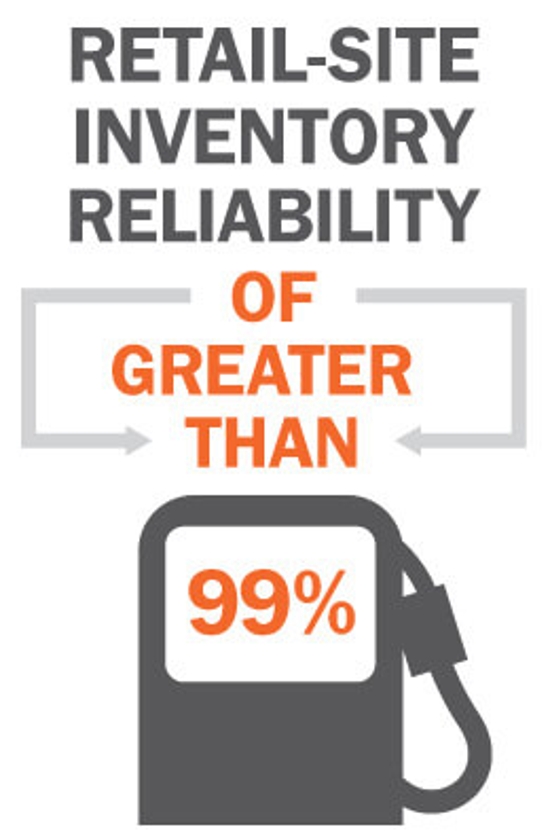Shipper | Case study
Harmonized transportation management optimizes supply chain performance
Background
One of the nation’s largest fuel-producing companies looked to salvage the transportation and inventory management within five of their major channels of trade, which collectively transport an average of more than 1.5 billion gallons of product with 47 carriers and a private fleet. The fuels value chain has nearly 700 retail, aviation, commercial, ethanol and asphalt stations – resulting in an average of more than 190,000 moves annually.
Situation
In the retail channel of trade on the East Coast, the company operated with several carriers and a private fleet. The decentralized operations ran seven disparate operating systems, and run-outs of fuel were prevalent, causing broker dissatisfaction with delivery performance and lost revenue. The company was subject to customer penalties within the commercial channel of trade due to supply interruption and lack of on-time deliveries within customer-specified windows based on the lift time and the invoice requirements. And time critical inbound shipments were needed to keep terminals in supply for proper product mix.
From a data perspective, the company didn’t have load-level business intelligence to control their operations. Further complicating the situation: resource constraints coupled with messy data made it difficult for the company to catch cost-saving opportunities in areas of optimization, transit time and accessorial trends.
Complex and intermixed systems caused inaccurate and inefficient invoice payment. Since it lacked the data infrastructure to match invoices to actual load execution, the company paid summary invoices as presented – without challenging inconsistent rates or incorrect services.
A drastic continuous improvement initiative was needed to remedy the deficiencies in its supply chain in order to reduce cost, improve reliability, elevate carrier performance and streamline the payment process.
Solution
The fuel value chain looked to Schneider’s SCM team to stabilize retail station inventory levels, prevent run-outs, bring control to their invoicing and provide load-level business intelligence through Schneider’s load tendering, load monitoring, carrier management, information management and carrier payment resolution. The partnership put Schneider in charge of simplifying a network of more than 190,000 moves a year and 1.5 billion gallons of product delivered. With Schneider focusing on solving the problem areas, the customer would be able to concentrate on their core competencies of demand forecasting, replenishment planning, internal supply and HSSE oversight.
Schneider’s involvement enabled the company to evolve their organizational structure by reforming the front and back offices. Schneider’s 24/7 coverage allowed the customer to simplify their scheduling center’s framework to staff Monday through Friday, covering a modest 50 hours per week. In addition, Schneider’s ability to flex staffing levels and prioritize resources also has demonstrated effective business continuity in crisis management.
Elevating carrier execution was driven by Schneider’s design and implementation of a carrier scorecard to improve delivery within a tendered window, accessorial cost trends and process adherence.
Schneider also identified a four-part strategy to create a smoother carrier network:

Improve terminal efficiencies, thereby reducing loading time and demurrage

Optimize carrier load to ensure that loads meet minimum volume requirements

Automate carrier invoice validation

Streamline order-to-cash processing with continuous improvement initiatives
To enable third-party fuel suppliers and to add load-level validation to the company’s order- to-cash cycle, Schneider created a solution to match Bill of Lading information against the actual load delivery information.
Lastly, Schneider automated the invoicing process and aligned the invoices on a load-level basis to allow consistency through the order-to-cash cycle as well as provide a definitive record of appropriate charges for transportation services.
Results
Partnering with Schneider and evolving their fuel delivery model helped the company realize $10.5 million of savings in years one through four. An additional $1.5 million in savings was achieved in year five. Freight payment, right-sizing, fuel offers and commercial options, system outsourcing and upgrades, simplification in the front and back offices, and driver cost transparency all improved.
The company consolidated their operating systems into one, down from seven. Their carrier base was initially reduced 36%, from 47 to 30. Roughly four years later as the business experienced diversification the base expanded again, aiding in the negotiation of lower prices.

Schneider’s carrier strategy to restructure the fuel carrier network was a success. In two years, Schneider’s solution to reduce loading time and optimize carrier loads identified an additional $2.3 million in transportation costs, process improvement initiatives and loading facility efficiencies.
Inventory management improved as Schneider helped establish a consistent retail-site inventory reliability of greater than 99% through management of inbound site calls, collaboration with dedicated carriers and load-level information management, effectively avoiding run-outs.
The fuel delivery company’s unchecked summary invoices were soon a thing of the past, with Schneider SCM’s Information Management making it easier for them to capture line item costs and improve efficiencies in both budgeting and pricing.
The numbers prove Schneider’s solution worked, and now the customer has visibility to detailed network opportunities – something they never had the luxury of experiencing before working with Schneider. Perhaps even more exciting are the long-term benefits of Schneider’s solution, with the success having been recognized by other business units as delivering results beyond all expectations.
Drive your business forward
Sign up to receive our industry leading newsletter with case studies and insights you can put to use for your business.












